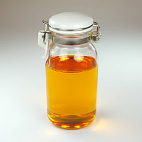Reason of Good Taste
 Namashibori Process, Soy Beans of Toyama Prefecture 100%, Natural Bittern from Noto Salt Field Produce 100%
Namashibori Process, Soy Beans of Toyama Prefecture 100%, Natural Bittern from Noto Salt Field Produce 100%
Material

Soy Beans
“Sweet, mellow and deep rich, but refreshing.” The first tofu we were impressed by at a tofu shop in Fukushima prefecture of excellent taste became real. What tofu to make? The tofu making started by selecting the kind of soy beans to match the tofu imaged. Mouthfeel is different depending on the kind of soy beans and even with the area in the same field that the beans grew. Nagaeya uses 100% of Toyama beans. There is no worry of gene recombination.

Bittern
“Bitter!” When tasting bittern you will bend backward with the bitterness However, when it is mixed with soy milk, a tasty tofu is made. How wonder! Nagaeya uses 100% of the natural bittern from the Okunoto Salt Field Village. The salt there is made by the Agehama process, the only method in Japan with some 500 years of history, requiring heavy human labors. The drops dripping when the salt cruds are the natural bittern. The color is yellow. It is indicated as “crude magnesium chloride” in the tofu label.

Water
Toyama prefecture is blessed with excellent underground water as said, “When you turn a faucet, it is mineral water coming out.” The people in Toyama live a luxurious life possible to use the high quality water for washing face, bathing, cleaning, etc. The steepest torrent worldwide of the Joganji River flows down from the famous Tateyama Mountains. The snow melt limpid water of 3000 meters high of the North Japanese Alps soak into the ground deeply and filtered slowly. The water of the Yatsuo town is pumped up the underground water from the Jogannji River, which makes the tofu of Nagaeya fresh. It is the most suitable soft water for making tofu.

Oil
Nagaeya uses 100% domestic rapeseed oil to make the deep-fried tofu. The oil is made by man hands and the power generated by fuel wood burn for all processes to roast, steam, smash and squeeze rapeseed. The rapeseed after smashed is filtered by the traditional method called “Tamajime” that is done using the filter made of human hair, which is rarely seen nowaday. The oil is further filtered carefully by handmade paper, washi, in cylindrical shape. The additive free oil is made by the Hiraide Oil Factory in Aizu-Wakamatsu, Fukushima prefecture, which has been succeeded from the Meiji era.
Process
“Namashibori” – the attentive process that draws out the only tasty part of soy beans
When we compress raw soy beans, a sweet smell comes to drift. The smell indicates a tasty tofu is being made. Nagaeya’s tofu is made by the “Namashibori” process which was introduced from Korea or China in the old time. This method is rarely done nowadays, and the present common process is “Nishibori” instead. In the namashibori process the soy beans that were soaked in water overnight are smashed by a grinder and made into “go”, a creamy paste. This process is the same as the nishibori process. In namashibori the go is compressed and filtered first before boiled, to separate raw soy milk and okara refused. Since the soy bean paste is firm, it requires time and labor taking about three hours to be done. The okara is still wet including a lot of soy milk. Though the soy milk produced in namashibori process is much less than that in the nishibori process, the taste is pure without unpleasant residue. Nagaeya adopted the namashibori process to draw out the tasty part only as much as possible even though it is an inefficient method. Nagaeya doesn’t use an antifrething agent to remove the bubble that arises when soy milk is made. Whenever bubble arises, it is removed manually.
 The tofu to make with manual labortastes of a gentle bean.
The tofu to make with manual labortastes of a gentle bean.
Difference of Namashibori from Nishibori.
Namashibori Process.
(1)Soak soy beans overnight
(2) Grind and smash the soy beans to make creamy paste

(3)Compress and filter the paste to divide it into soymilk and okara refuse
(4)Boil the soymilk only
Nishibori Process
(1)Soak soy beans overnight
(2)Grind and smash the soy beans to make creamy paste

(3)Boil the whole paste
(4)Compress and filter to divide into soymilk and refuse



